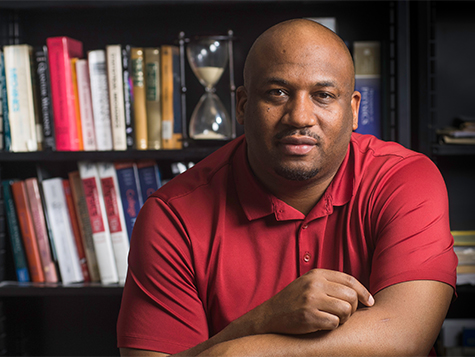 Clayton E. Simien, Ph.D.Clayton E. Simien, Ph.D., an assistant professor in the Department of Physics at University of Alabama at Birmingham College of Arts and Sciences, has been awarded a National Science Foundation Career Grant for research on atomic clocks and low-temperature plasmas.
Clayton E. Simien, Ph.D.Clayton E. Simien, Ph.D., an assistant professor in the Department of Physics at University of Alabama at Birmingham College of Arts and Sciences, has been awarded a National Science Foundation Career Grant for research on atomic clocks and low-temperature plasmas.
Simien was awarded $483,538 for the grant, “Laser Cooling and Trapping of Beryllium: Frozen Plasmas and Precision Measurements.” Beryllium is an alkaline Earth metal traditionally used as a hardening agent in alloys. Now, Simien will investigate its potential in a vapor phase as an atomic clock and ultracold neutral plasma.
“Atomic clocks have been instrumental in the advancement of science and technology in the 20th century,” said Simien, a research professor in the UAB Department of Physics. “They have led to innovations such as global positioning, advanced communications and tests of fundamental theories of particle physics.”
Through Simien’s research, a next generation optical atomic clock of beryllium could extend the capabilities of current systems and enhance security for data routing and communications, advance Earth and space time-based navigation, and further precise testing of Einstein’s general theory of relativity.
In addition, the element will be investigated for use in producing an ultracold neutral plasma, or gas of ions and electrons. Ultracold neutral plasmas are laser-produced plasmas that stretch the boundaries of traditional plasma physics.
Studies of these table-top ultracold systems are promising to greatly improve scientific understanding of much hotter and denser plasmas thought to occur in many high-energy density and astrophysical systems.
“The goal of this project is to laser-cool, trap and photo-ionize neutral atomic beryllium for its potential use as an optical frequency standard, and to produce a UCNP at a sufficiently low temperature for ionic crystals to form inside the system, virtually freezing the plasma,” Simien said.
This award will also allow UAB to attract and retain more underrepresented students to physics studies. The project will involve minority graduate, undergraduate and high school students to participate in research projects in the Simien Spectroscopy and Laser Cooling group. Additional outreach activities will aim to increase interest in science and engineering from elementary, middle school and high school students by performing physics and chemistry demonstrations at local schools in the region.